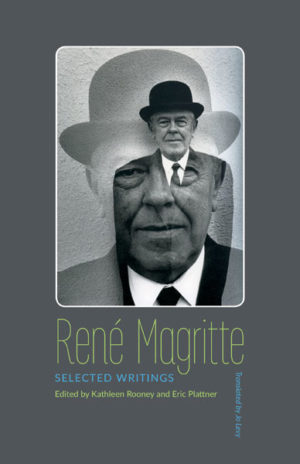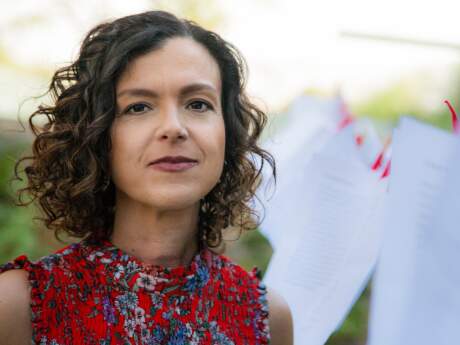In Their Own Words
Kathleen Rooney on René Magritte’s “Selected Writings”

The Alphabet of Revelations: On the Poetic Importance of René Magritte's "Selected Writings"
When he was young, René Magritte tried his hand at being an author, drafting detective novels as "Renghis", a pseudonym created through the combination of his first and middle names: "René" and "Ghislain".
And then, as everyone knows, he went on to become a world-renowned painter, not a mystery writer. Yet he remained a passionate lifelong reader, and many of his images have titles taken from various books, including Alice au pays des merveilles after Lewis Carroll, L'Au-delà after François Grégoire, Les Fleurs du Mal and La Géante after Charles Baudelaire, Gaspard de la Nuit after Aloysius Bertrand, L'Île au trésor after Robert Louis Stevenson, Le Château des Pyrénées after Ann Radcliffe and Le Domaine d'Arnheim after his greatest literary hero, Edgar Allan Poe, to name a few.
But as fewer people know, so too did Magritte continue writing, becoming a versatile and genre-jumping author of essays, prose poems, manifestos, polemics, lectures, reviews, film scripts, memoirs, interviews, pamphlets, aphorisms and plays on words and images.
In an interview with Michel Géoris in 1962, Magritte says that, "For me, painting is bringing my thoughts to life. I very much like poets and writers, but I am not a writer, so I think in images, not in novels and poems." Magritte is technically correct in his self-assessment, of course. He was not a poet per se, nor was he primarily known as a writer, but even he could not deny that he was a painter who wrote, and who wrote compellingly. His written output is both significant in its own right and because his images are so carefully authored themselves. In short, the material in René Magritte: Selected Writings—translated by Jo Levy, co-edited by Eric Plattner and myself, and published by the University of Minnesota Press and Alma Books—available now in English for the first time, makes the case for Magritte to be understood as not just as a painter but as a literary figure.
The abundant verbal skill on display in his Selected Writings likely won't surprise admirers of Magritte's paintings, works in which he is witty and ingenious in his concerns with language, semantics and "the use of the word", as he called several images: L'Usage de la parole. Over the course of his lengthy and prolific career, Magritte executed numerous works—far too many to name here – with text in them. Le Bouchon d'épouvante (The Fright Stopper), for instance, features one of his signature bowler hats bearing the label "FOR EXTERNAL USE ONLY". Le Paysage fantôme (The Phantom Landscape) presents a portrait of his wife Georgette's friend Suzanne Dhout, with the label "montagne" (mountain) running diagonally across her cheeks and nose. Le Paysage isolé (The Lonely Landscape) depicts a man, seen from behind, looking at a vista and with a speech bubble containing the words "je ne vois rien autour du paysage" or "I see nothing around the landscape".
In these works and others, Magritte takes delight in disrupting the purported meanings of words and images, meanings that many people take for granted as being fixed or finite. He playfully yet seriously reminds the viewer not to confuse resemblance or likeness with representation, calling attention to the ambiguities, uneasinesses and even epiphanies that can arise when familiar objects and words are placed in unexpected contexts.
His writings tend to pursue similar aims, and it is important to note that they are not needed to understand the paintings, but are instead stand-alone works, worth reading in their own right. Many of them do add insight to the way that Magritte almost perpetually interrogates linguistic and pictorial systems of representation, but they do so on their own terms and as self-contained pieces.
Throughout his career, spanning over four decades, Magritte investigated again and again not just the distance between images and language, but also between language and images and the things they purport to name or represent. He did so perhaps most famously in the near-ubiquitous La Trahison des images (The Treachery of Images), with its illustration of a pipe and its statement Ceci n'est pas une pipe ("This is not a pipe"). Magritte dedicated much of his output, both visual and literary, not simply to warning of the treachery of images, but also to warning of the danger of failing truly to look at things, or of trusting in received ideas or abstractions.
On canvas and on paper, he reminds his audiences never to resort to habit or prescribed emotions, but to do and see and feel for themselves. By questioning the everyday, he renders it extraordinary, giving both ordinary and extraordinary things back to viewers and readers.
Fittingly, given his early writings, as well as his affinity for Fantômas, Nat Pinkerton, Nick Carter and other fictional characters like them, Magritte can be understood, both visually and literarily, as a kind of detective, questioning everything commonly presented as reality and empirical truth and looking for clues to reveal what he perceived to be the all-important mysteries of life. In his essay 'Life Line', he concludes: "All these hitherto unknown things that are coming to light suggest to me that our happiness too depends on an enigma associated with man and that our one duty is to try to solve it."
In the short prose poem 'Mystery is Not…' he writes: "Mystery is not one of the possibilities of reality. Mystery is what is absolutely necessary in order for reality to exist." And that is what, like the paintings, these writings offer: mystery without mystification.
His writings offer insight into the mystery of his images. But even when they appear expressly to address a particular painting—as in the prose poem 'The Legs of the Sky', for instance, which could refer to Les Muscles célestes (The Muscles of the Sky) and 'A Walk in the River', which could refer to Les Habitants du fleuve (The Denizens of the River)—they should not be considered explanations or interpretations. Magritte did not want his work to be reducible to a puzzle to be solved, writing in 'Life Line' that "Titles must be an additional protection to discourage all attempts to reduce poetry to a pointless game". Even more explicitly, he writes in 'On Titles' that "The relationship between title and picture is poetic—that is, it only catches some of the object's characteristics of which we are usually unconscious, but which we sometimes intuit when extraordinary events take place which logic has not yet managed to elucidate".
In other words, just as a poem cannot be paraphrased, Magritte's pictures cannot be—and are not here—in any way summed up. Rather, Magritte's writings stand equally as marvelous writerly pieces in their own right and as invaluable glimpses into what goes into thinking about images and the visual world to make new artistic creations. In fact, it's worth noting that he thought of painting as a type of poetry.
In 'A Poetic Art', he writes: "The art of painting, as I see it, makes possible the realization of visible poetic images." And his definition of poetry—as effective a definition as can be found anywhere—is that it must be surprising and enchanting. In the short essay 'L'Empire des lumières'—jumping off from his image of the same title in which the landscape on the ground is nocturnal, but the sky is daylit—he writes: "This evocation of day and night seems to me to have the power to surprise and enchant us. I call this power 'poetry'." His pictures are certainly full of surprise and enchantment, and so is his writing.
Moreover, Magritte's writing, like his painting, is neither automatic nor stream-of-consciousness, techniques popular among his fellow Surrealists, particularly early on in the movement. His words, like the objects in his images, are carefully chosen, meticulous and deliberate. In a letter to Volker Kahmen in 1967, Magritte asks the art historian to cut the word "dream" in reference to Le Domaine d'Arnheim, because "the dream is sub-reality—that is, there is nothing poetic about it". In the same letter, Magritte offers his notion of the function of poetry, saying, "Poetry gives a sense of passion to a reality we have found to be inadequate: it is surreality. It is a response to the feeling of universal mystery."
In his writing, too, he urges his audience not to settle for what they are told is the so-called real world. In his essay 'Surrealism in the Sunshine', he argues:
Life is wasted when we make it more terrifying, precisely because it is so easy to do so. It is an easy task because people who are intellectually lazy are convinced that this miserable terror is "the truth", that this terror is knowledge of the "extra-mental" world. This is an easy way out resulting in a banal explanation of the world as terrifying. Creating enchantment is an effective means of counteracting this depressing, banal habit.
Here and throughout his Selected Writings, he reminds readers that they should not resign themselves to a mediocre or terrifying reality, but should instead aspire towards the better, more satisfying and equitable worlds which might be possible.
His belief in the necessity of the creation of enchantment shows that Magritte is not merely a detective, then, but also a magician. He writes in 'Ariadne's Thread':
But if we believe in the reality of the poetic act and try to discover its meaning, we find a new direction which instantly leads us away from that sterile region which the mind wears itself out attempting to make fertile. The aim of poetry would then be to discover the secrets of the universe, which would give us power over the elements. Magic would be possible.
This application of poetry—visual and verbal—towards the discovery of secrets is perhaps what causes him so frequently to award the descriptors "poetry" or "poetic" as marks of his highest praise. Of the Italian artist Giorgio de Chirico, an early and lifelong influence, he writes: "This triumphant poetry has replaced the stereotyped effect of traditional painting. It is a complete break with the intellectual habits peculiar to artists who are prisoners of their talent, virtuosity and all petty aesthetic frills. It is a question of a new vision where the viewer rediscovers his isolation and hears the silence of the world." So important was poetry to Magritte that he sometimes sought help from his friends, particularly the poets Paul Nougé and Louis Scutenaire, on the titles of his images. And in the end, his own writings suggest that Magritte is himself a poet of sorts, not just figuratively or as a term of respect, but truly.
University of Minnesota Press is releasing René Magritte: Selected Writings in the States this Fall and Alma Books is releasing it simultaneously in the UK. Here are a couple of the artist's prose poems, which originally appeared in the little magazine Distances, edited by his friend, the Belgian poet Paul Nougé, in 1928:
The Man with the Aimless Face
Everyone looks like him, but he has his eyes open. He is the master of memories, he clarifies the appearance of things. His dream is infallible.
Theater Right in the Heart of Life
Doubtless it was a princess coming out of the wall, smiling, in the house surrounded by a magnificent sky. On the table were choice fruits, looking like birds. The lighting was comprehensible, despite a few unaccountable shadows and the lack of perspective beyond the open doors. The whole was dynamic thanks to the proportions.
Now the princess is running, an amazon without vertigo, in the boundless fields searching for mysterious proofs. She uses up the thoughts and acts of an infinite crowd of people. She gets over poetic obstacles: suitcase, sky; penknife; leaf; sponge, sponge.



